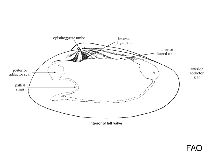Mesodesma mactroides Reeve, 1854
Yellow clam| Native range | All suitable habitat | Point map | Year 2050 |

|
| This map was computer-generated and has not yet been reviewed. |
| Mesodesma mactroides AquaMaps Data sources: GBIF OBIS |
Google image | No image available for this species;
drawing shows typical species in Mesodesmatidae.
Classification / Names Common names | Synonyms | CoL | ITIS | WoRMS
Bivalvia | Venerida | Mesodesmatidae
Environment: milieu / climate zone / depth range / distribution range Ecology
Benthic; depth range 0 - 1 m (Ref. 83435). Tropical; 22°S - 42°S, 63°W - 41°W (Ref. 83435)
Distribution Countries | FAO areas | Ecosystems | Occurrences | Introductions
Southwestern Atlantic: from Ilha Grande (Brazil), Barra del Chuy to La Coronilla (Uruguay), to Isla del Jabali (Argentina).
Length at first maturity / Size / Weight / Age
Maturity: Lm ? range ? - ? cm Max length : 9.7 cm DL male/unsexed; (Ref. 83435)
Life cycle and mating behavior Maturity | Reproduction | Spawning | Eggs | Fecundity | Larvae
Main reference
References | Coordinator | Collaborators
Rosenberg, G. 2009 Malacolog 4.1.1: A Database of Western Atlantic Marine Mollusca. [WWW database (version 4.1.1)] URL http://www.malacolog.org/. (Ref. 83435)
IUCN Red List Status
(Ref. 130435: Version 2025-1)
CITES status (Ref. 108899)
CMS (Ref. 116361)
Threat to humans
Human uses
| FishSource |
Tools
More information
Max. ages / sizes
Length-weight rel.
Length-length rel.
Length-frequencies
Mass conversion
Abundance
Internet sources
BHL | BOLD Systems | CISTI | DiscoverLife | FAO(Publication : search) | Fishipedia | GenBank (genome, nucleotide) | GloBI | Gomexsi | Google Books | Google Scholar | Google | PubMed | Tree of Life | Wikipedia (Go, Search) | Zoological Record



